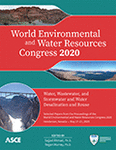World Environmental and Water Resources Congress 2020
A Multi-Faceted CFD Evaluation of an Existing Secondary Clarifier
Publication: World Environmental and Water Resources Congress 2020: Water, Wastewater, and Stormwater and Water Desalination and Reuse
ABSTRACT
As part of the Great Lakes Water Authority’s Water Resource Recovery Facility Comprehensive Regional Wastewater Master Plan, computational fluid dynamics (CFD) modeling was used to evaluate the performance and capacity of an existing secondary clarifier. The hydraulic performance was evaluated using three-dimensional (3D) CFD models, and process performance was evaluated using a two-dimensional (2D) CFD model. The clarifier inlet configuration is very complex and unique, where flow is conveyed into the circular clarifiers from a series of diffuser pipes around the periphery. To accurately represent flow into the clarifier from the diffusers, it was essential that the flow through the diffuser be modeled. Modeling flow through each of the 73 inlet diffusers and the clarifier simultaneously proved to be impractical considering the computational resource requirements. Therefore, two separate 3D CFD models were created for a single inlet diffuser and the entire secondary clarifier. The high-resolution single inlet diffuser model was used to both determine and define the inlet boundary conditions of the clarifier model. The velocity field and shear flocculation potential predicted by the 3D CFD models were considered as well as the 2D CFD simulations, which included sludge characteristics and density currents to predict clarifier process performance and capacity. In this paper, the multi-faceted CFD evaluation used to determine the future capacity potential for the GLWA WRRF secondary clarifiers will be discussed. Overall, the model results indicated the performance of the existing secondary clarifiers would not be compromised with an increased surface overflow rate. The paper will detail the approach and results that led to that conclusion.
Get full access to this article
View all available purchase options and get full access to this chapter.
ACKNOWLEDGEMENTS
The authors thank the Great Lakes Water Authority for their contributions and support for this project.
REFERENCES
Bridgeman, J., B. Jefferson, and S. A. Parsons. (2010). The Development and Application of CFD Models for Water Treatment Flocculators. Adv. Eng. Softw., 41(1), 99–109. https://doi.org/10.1016/j.advengsoft.2008.12.007.
Camp, Thomas R, and Philip, C Stein. (1943). Velocity Gradients and Internal Work in Fluid Motion. J. Boston Society Civil Engineers 85, 219–37.
Innovative Hydraulics. (2016). Visual Hydraulics 4.2. User’s Manual.
McCorquodale, J. A., Griborio, A., Georgiou, I. (2005). A Public Domain Settling Tank Model. In Proc. Water Environ. Federation 78th Conf. & Expos. (pp. 2546-2561). Washington, D.C.: Water Environment Federation.
Metcalf & Eddy, Inc. (2014) Wastewater Engineering: Treatment and Resource Recovery. (5th ed.). Boston: McGraw-Hill.
Shih, T.-H., Liou, W. W., Shabbir, A., Yang, Z., and Zhu, J. (1995). A new k-εeddy viscosity model for high Reynolds number turbulent flows. Computers & Fluids, 24(3), 227–238.
Wastewater Committee of the Great Lakes – Upper Mississippi River Board of State and Provincial Public Health and Environmental Managers (Ten State Standards) (2014). Recommended Standards for Wastewater Facilities: Policies for the Design, Review, and Approval of Plans and Specifications for Wastewater Collection and Treatment Facilities. Albany, N.Y.: Health Research, Inc.
Water Environment Federation (WEF) Clarifier Design Task Force (2005). WEF Manual of Practice No. FD-8 Clarifier Design. Alexandria, VA: WEF Press.
Water Environment Federation (WEF) (2012). Design of Water Resource Recovery Facilities (WEF Manual of Practice No. 8; ASCE Manuals and Reports on Engineering Practice No. 76). Boston: McGraw-Hill.
Information & Authors
Information
Published In
World Environmental and Water Resources Congress 2020: Water, Wastewater, and Stormwater and Water Desalination and Reuse
Pages: 154 - 167
Editors: Sajjad Ahmad, Ph.D., and Regan Murray, Ph.D.
ISBN (Online): 978-0-7844-8298-8
Copyright
© 2020 American Society of Civil Engineers.
History
Published online: May 14, 2020
Published in print: May 14, 2020
Authors
Metrics & Citations
Metrics
Citations
Download citation
If you have the appropriate software installed, you can download article citation data to the citation manager of your choice. Simply select your manager software from the list below and click Download.
